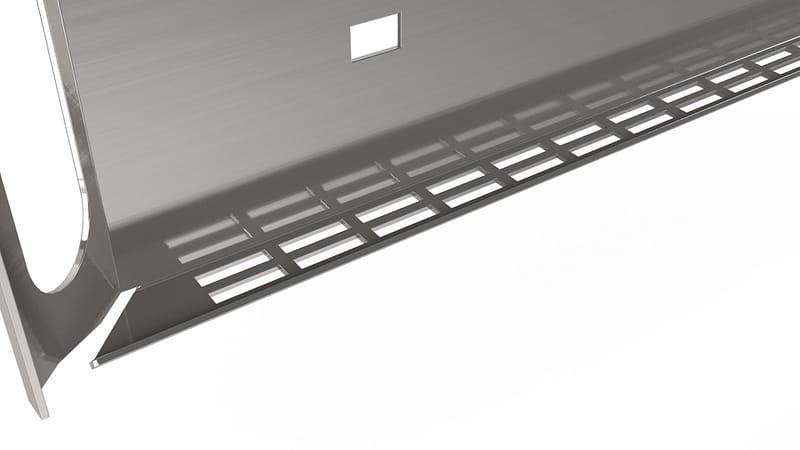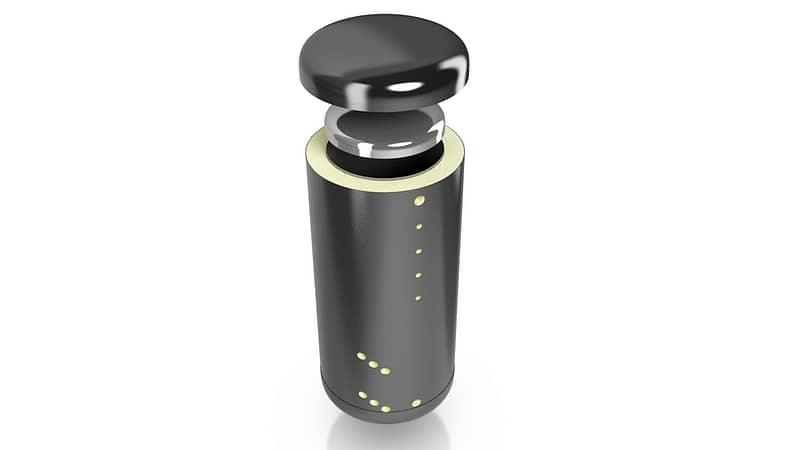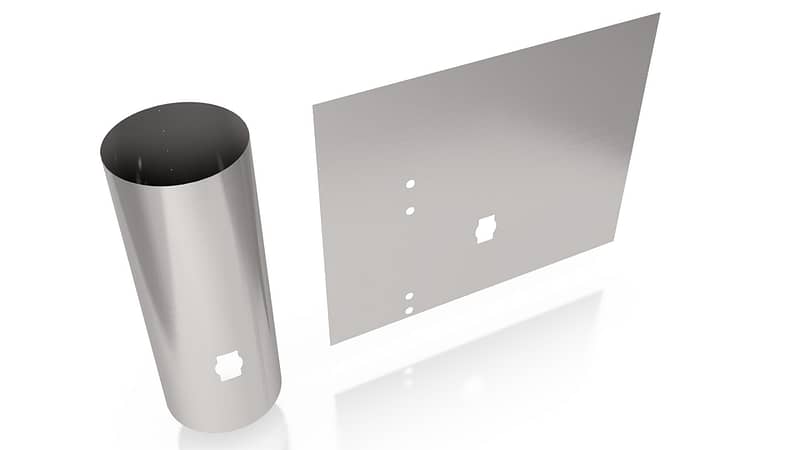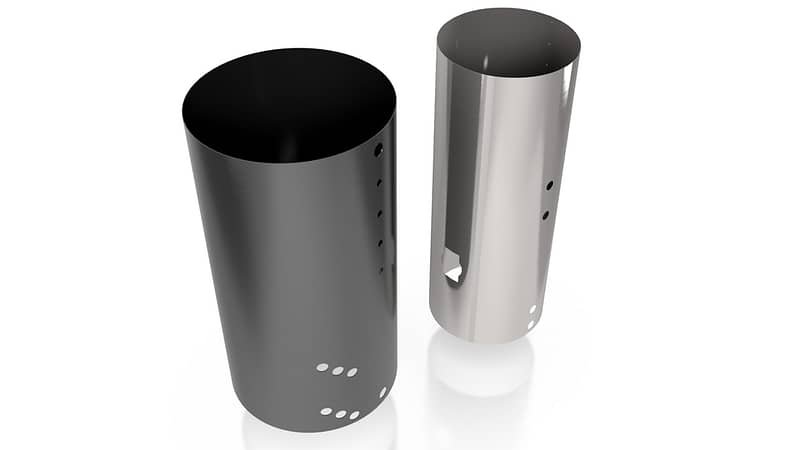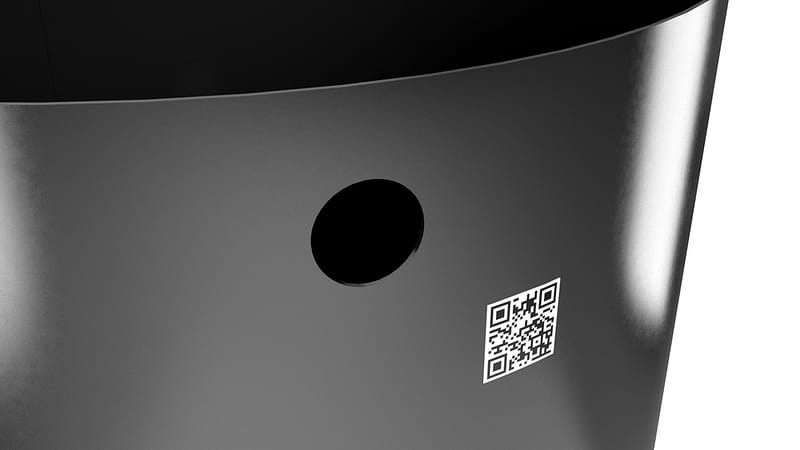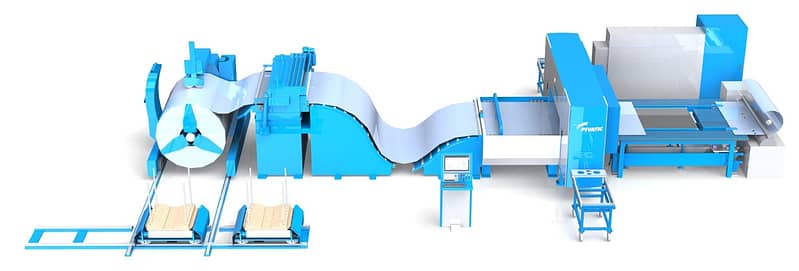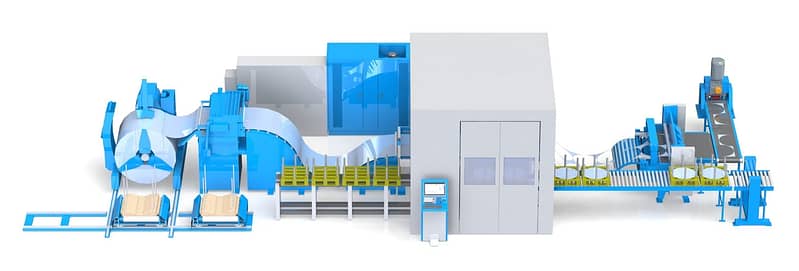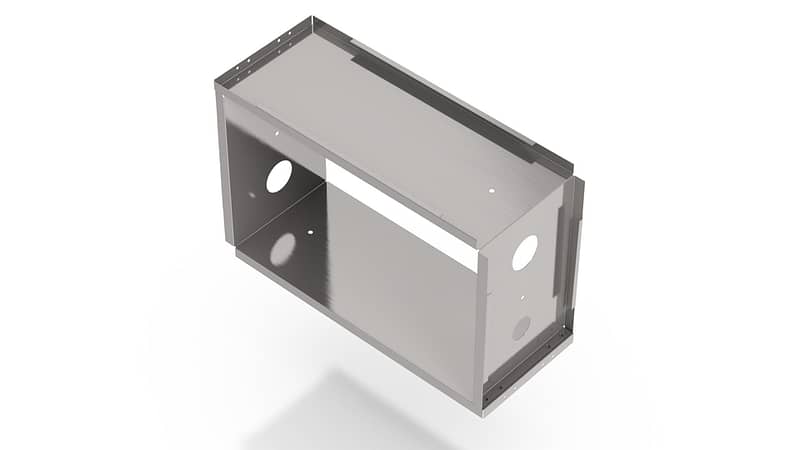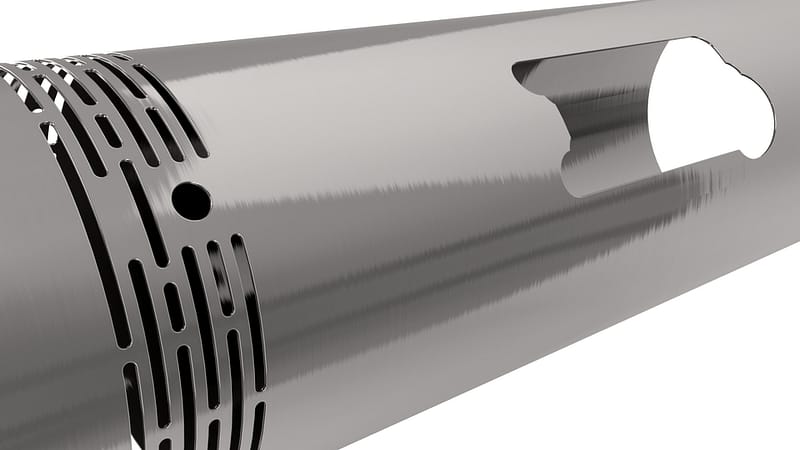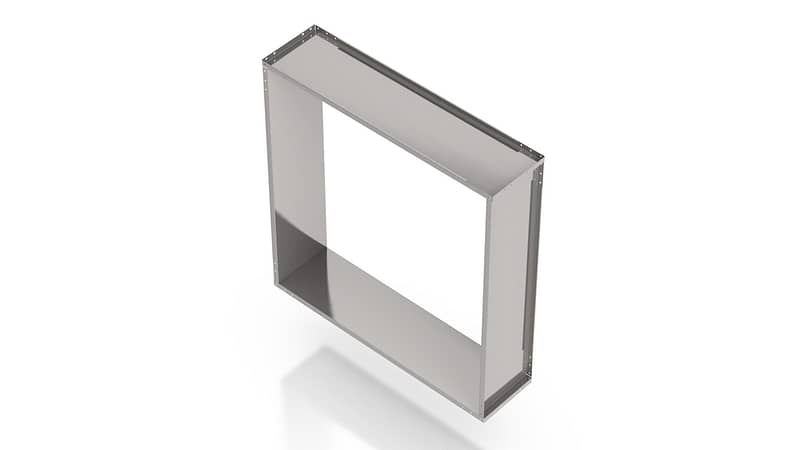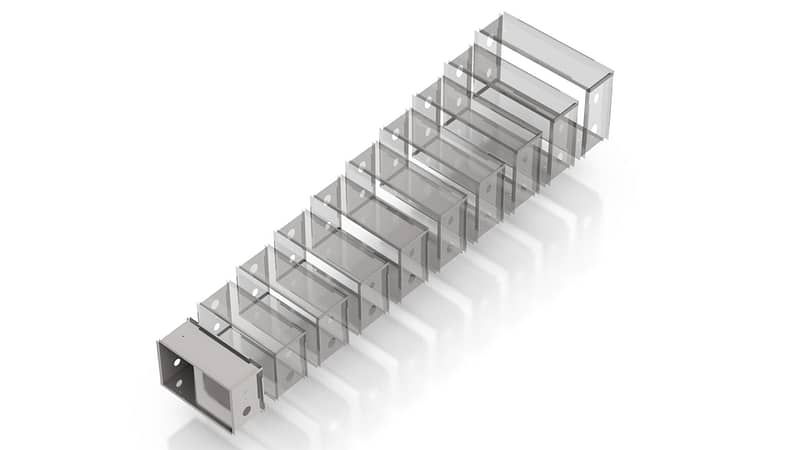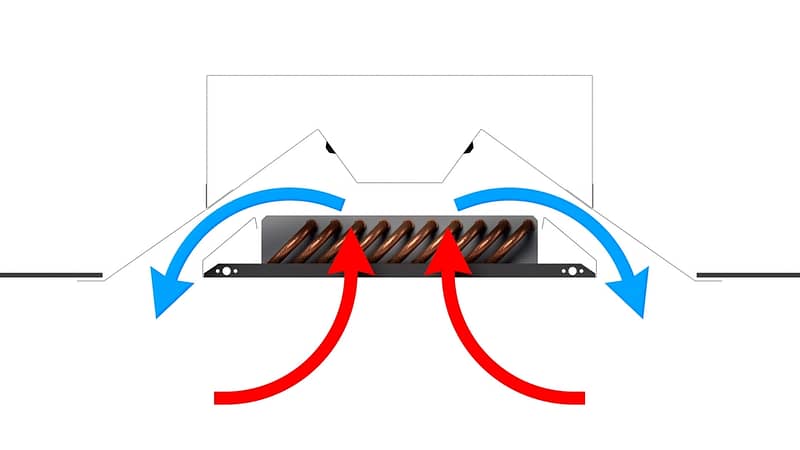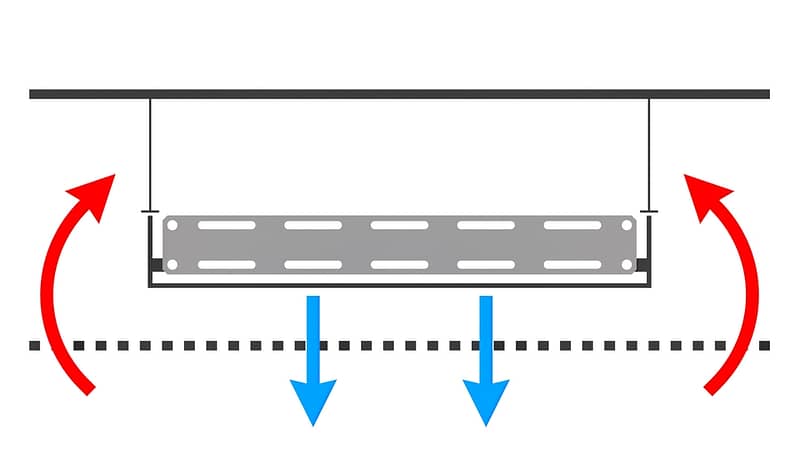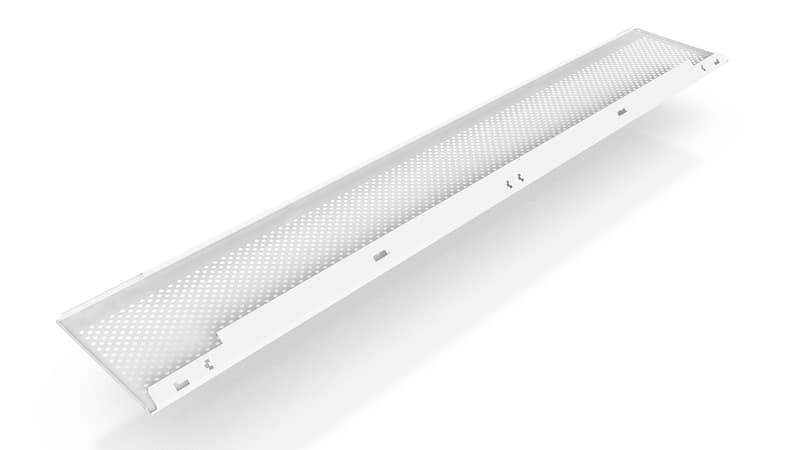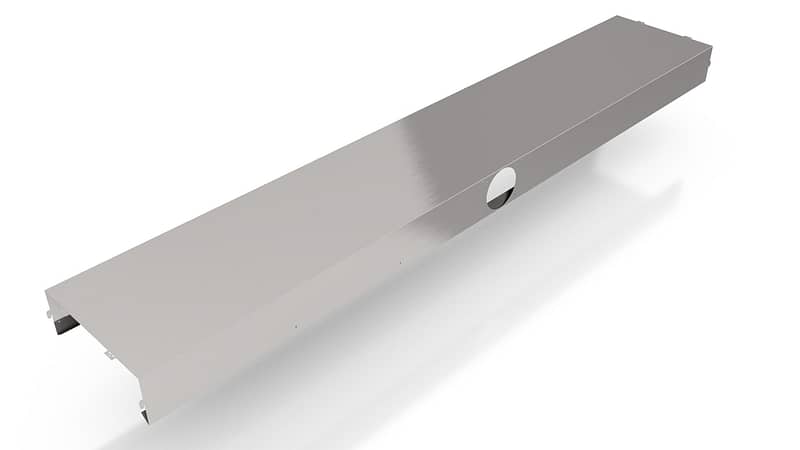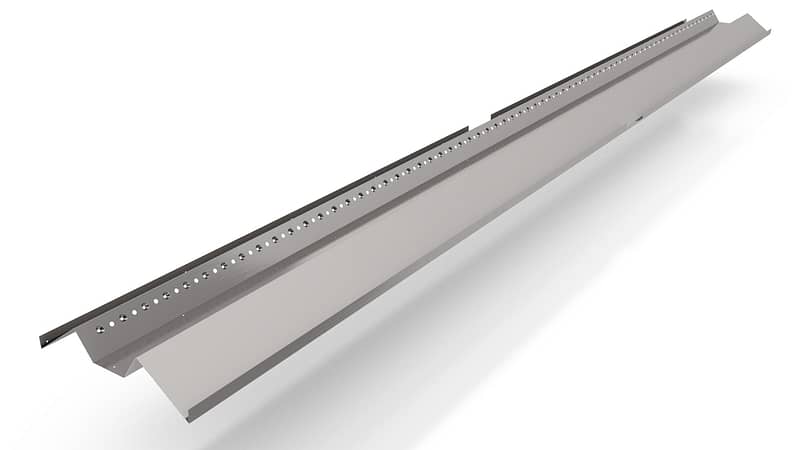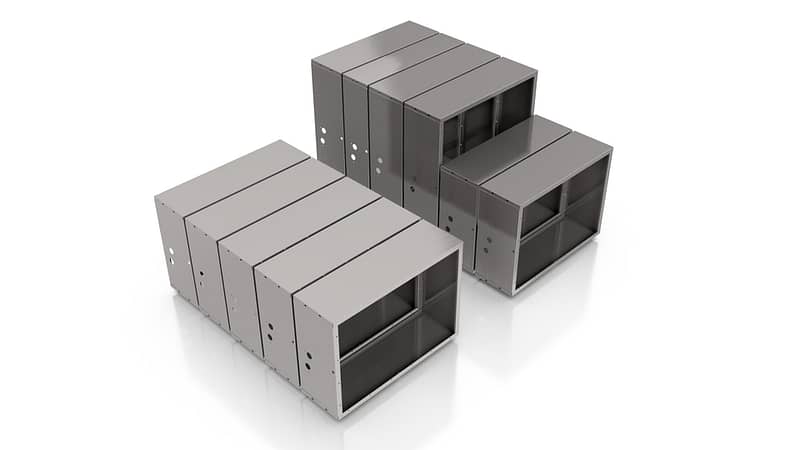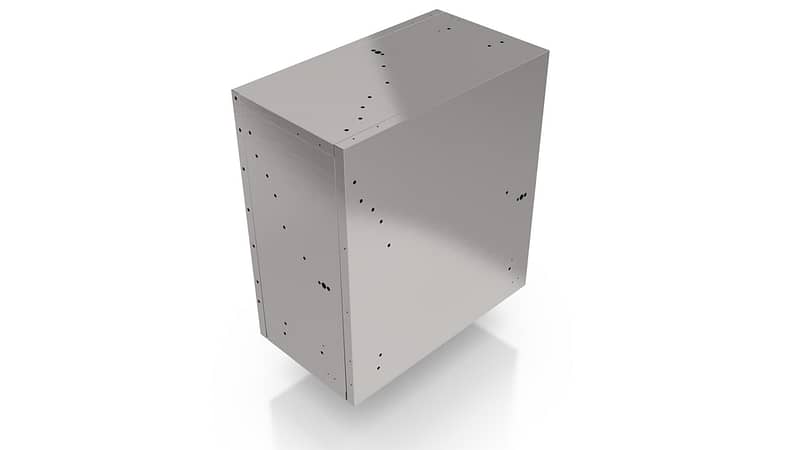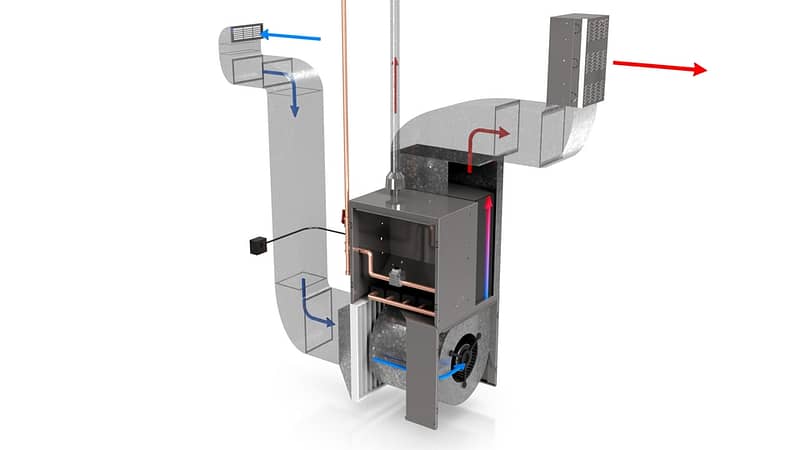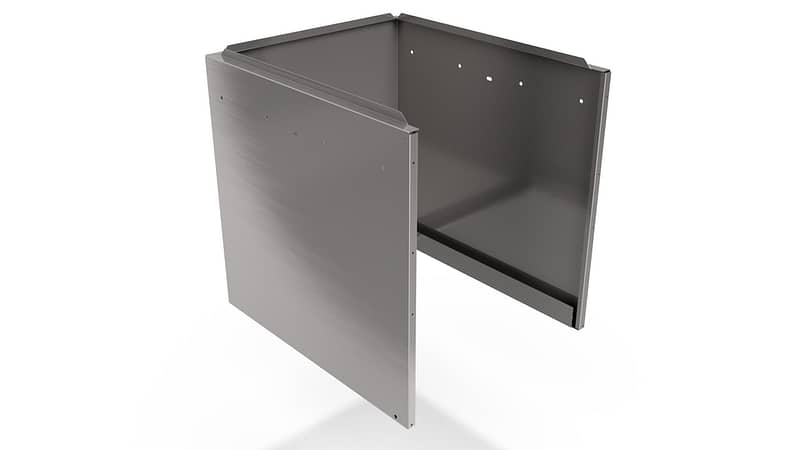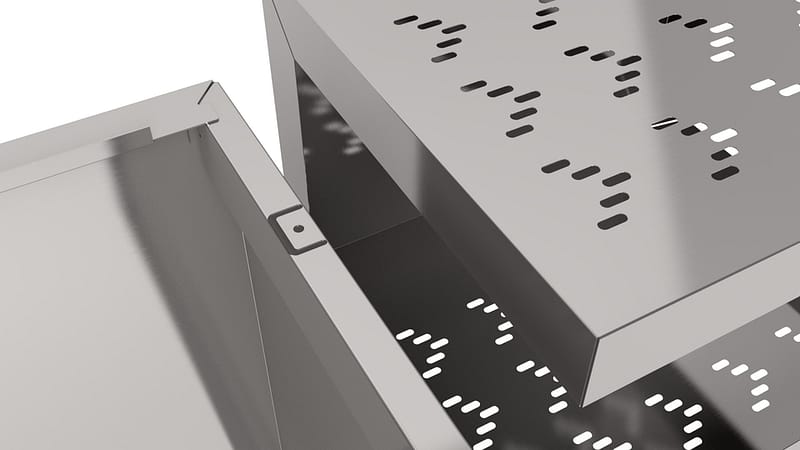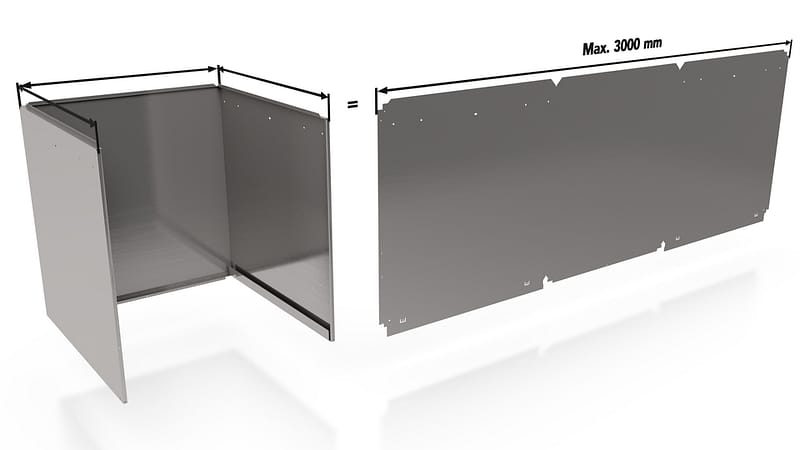Heating, ventilation, and air conditioning systems control the temperature, humidity, and purity of the air in residential and commercial buildings. It also includes the water heating and circulation systems. Sheet metal is used for both outdoor and indoor products due to corrosion resistance, durability, and repeatability in the process. The sector is growing due to rapid urbanization, improvements in the standards of living, and energy-saving programs in the construction business. The seasonality of the HVAC industry causes high fluctuations in the demand throughout the year.
Example products for the HVAC sector are air heaters, water heaters, ventilation fans and channels, fire dampers, chilled beams, fan coils, and air conditioners.
 Heating
Heating
 Ventilation
Ventilation
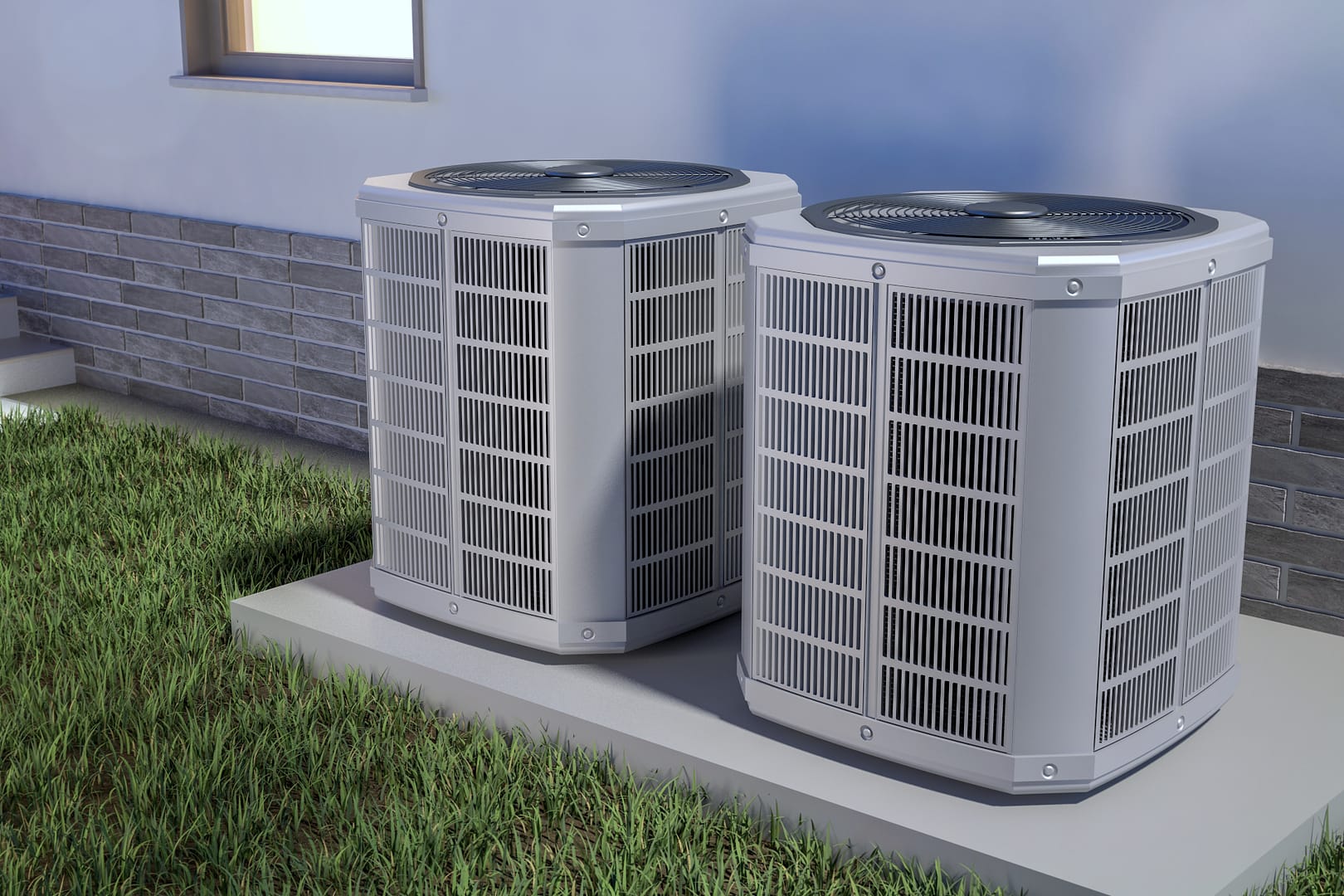 Air conditioning
Air conditioning
 Heating
Heating
Heating systems for air and water are used in both commercial and residential spaces. The total systems include different types of fans and conductors, but here we will focus on the terminal equipment of heating.
Our strengths and studies are about electric radiators and water heaters, but other examples of heating systems utilizing sheet metal are for example water radiators, oil heaters, panel heaters, furnace blowers, heat pumps, underfloor heaters, and garage heaters.
CHALLENGES AND REQUIREMENTS (ELECTRIC RADIATORS)
The mobile electric radiators and heaters are used as additional heating methods in buildings or areas where the fixed water, gas, or oil heating systems don’t suffice. The largest market for electric radiators is in Scandinavia and Russia. As the ways of producing electricity are advancing, electric heating is becoming more and more environmental-friendly compared to other ways of heating, although it was considered a great evil in the past.
Electric radiators are produced for both residential and commercial buildings like households, offices, leisure homes, and garages. Their demand is focused on the season of winter so the production efficiency and reliability at this time needs to be exquisite. These high-volume products of over 500 000 pieces per year from one manufacturer are produced in large series as assembly kits of the front plate and the back plate. The cycle time requirement for a single assembly kit is a demanding 40 seconds. Due to the seasonal nature of production, preparing for increasing demand requires that the new machines are installed and ready in time, as a delay in the schedule may lead to the project being carried over to the next year.
Process and Material
The material used in the radiators is thin 0.5 – 0.8 mm pre-painted mild steel without exception, so the process needs to be material-friendly without buffer storage. The punching and bending process should be in contact with the stage assembly, where the heating and electrical elements are installed on the back plate. Finally, the front and the back plates are clinched together. The product models are standardized with a few height variations and several widths. Size differences are due to the required heating power, assembly equipment, and appearance. Every manufacturer has its own range of radiator models. To have changes made for the radiator models is a very slow process due to electrical regulation approval projects, and manufacturers tend to use the same models for several years or even decades.
Punching
The challenges in punching are the several holes and openings for different attachments, assembly, and air circulation holes. The holes required for the front plate and the back plate are different: the back plate has several attachment holes, large corner notches, and the perforated supply air grate. The front plate has louver holes for the entire width of the radiator, so for different radiator widths, the press tooling needs to be programmable. The louvers are also so close to the long side edges that they have to be produced after bending to avoid being flattened. The products can also have branding as an extrusion form which also requires some press tool technology.
Bending
The challenges in bending come from the visual shapes of the front plates: rounded edges and complicated corners require special tooling for the benders. The long sides of the front plate and the back plate also have different profiles, so the bending machines need to be suitably flexible. By only having upward bends though, there is a selection of manufacturing technologies to choose from.
SOLUTION (ELECTRIC RADIATORS)
Pivatic offers fully automated production lines for manufacturing all of the required radiator sizes as assembly kits. The production line can run unmanned for long periods of time and it is easy to use, as all parts in the product families are programmed beforehand in the startup process of the project. Pivatic’s punching and bending line, the PivaSystem, can be integrated into the subassembly line without the need for buffer storage.
For the punching process, we recommend coil manufacturing, as the coil width can be chosen according to the radiator height. The radiator length is thus programmable and the process produces no excess slug. A flexible Thick Turret punching station has a minimum number of 24 slots to equip thick turret tools or cluster tools. The cluster tooling can be used for perforating the back plate supply air grate. A separate press tool is required for the louver forming, and it is added in the PivaBend process.
To have the bending process up to speed with the punching, we recommend a bending line with four bending units, one for each side of the part. After bending the long sides, the louvers are formed and the part is transported to the short side bending station. The upper hold-down tool of a short side bender is divided into sections so that it can be adjusted according to the width between the long side bends.
CHALLENGES AND REQUIREMENTS (WATER HEATER)
Domestic and commercial water heaters and storage tanks have sheet metal as the outer shell, inner shell, and top and bottom cups. The cover and the shells are single mild steel or stainless-steel sheets that are bent to the perimeter, and the end parts are formed from discs to create sealed containers. The total yearly volume of water heaters is in the hundreds of thousands.
The different parts have material requirements due to their resistance to heat; the inner shell and its end parts are in contact with hot water and require a duplex stainless-steel material to withstand corrosion. Mild pre-painted steel for the outer shell and end caps will suffice due to insulation in-between. The challenges for punching are the varying pipe insertion holes in the shells, automatic handling of the circular end discs, and the forming press technology required.
The inner shell is welded complete to eliminate possible leakage even in the highest of water temperatures. The outer shell is attached to the inner shell by a seam with a plastic strip. The products are marked for traceability and to help with the assembly process.
SOLUTION (WATER HEATER)
Pivatic offers different punching and forming solutions for the shells and the end parts, with the possibility of a fiber laser or mangle integration. For outer and inner shells, the coil punching solutions are recommended to have programmable length for the sheets to be cut to the shell diameter. The different heater heights can be manufactured from different widths of coils, up to 2000 mm / 78” wide. A flexible Thick Turret punching station can be equipped from 24 different punching tools upwards, and a press tool station will be used for circular cuts of the discs and/or forming the discs. A labeling, inkjet, or laser marking device can be added to meet the traceability requirements for the parts.
 Ventilation
Ventilation
Ventilation devices and channels take care of the distribution, filtering, and noise cancellation of fresh air and improve fire safety for factories, residential buildings, and commercial areas. The air handling devices in the technical areas, ventilation channels, and fire dampers within, as well as the end devices before room spaces, form the largest volume of sheet metal products in ventilation.
Other products for the ventilation segment are for example airflow dampers, chilled beams, air handling units, sound attenuators, smoke extractors, and industrial ventilation fans.

Air Handling
Chilled Beam
Fire Damper
CHALLENGES AND REQUIREMENTS (FIRE DAMPER)
Fire dampers prevent smoke and fire hazards from spreading between spaces, devices, or indoors and outdoors. They are a part of the rectangular or circular ventilation channels. Circular channels are used in areas that have low airflow requirements, and the channel walls and the fire dampers are mangled into circles and finished by welding or seaming them complete. For the rectangular dampers, the end part is assembled on-site from single-wall panels, two L-shaped parts, or a full square perimeter.
Process and Material
The small circular fire dampers are dimensioned according to standardized ventilation channels and are high-volume products, delivered from storage. The square mid-volume wall panels are tailor-made, manufactured, and delivered straight from the production with variable product dimensions every 1 mm apart. The material used is thin zinced mild steel 0.5 – 3.0 mm, occasionally acid-proof steel or stainless steel.
Punching
The challenges in punching fire damper parts come from the longitudinal thermoslit perforation, several channel attachment holes, and potential form extrusions in the parts. The process for circular dampers can be started by either turret punching the material, mangling and welding the circle – or by shearing the damper sheet to length, mangling, welding the circle, and laser cutting the required holes. The sheet size varies by standardized channel diameter and the required opening or closing motion of the damper. For rectangular dampers, a highly scalable punching technology is required, as due to tailor-made dimensions, there can be several tens or hundreds of different size parts per day.
Bending
The challenges in bending are the long rectangular damper wall panels or perimeters. The sizes of rectangular channels vary from 1000 x 1000 mm to 3000 x 3000 mm that are challenging to handle, manufacture and assemble automatically.
Both circular and rectangular dampers have had increased demand for traceability, and so a laser marking or inkjet printer is feasible to add to the process. To have mangling, welding, seaming, or assembly machinery in the same process would also prove beneficial.
SOLUTION (FIRE DAMPER)
Traditional manufacturing of fire dampers requires several steps, buffers, and manual work. The sheets are punched with a turret punch, mangled by hand, seamed, and finally the ends mangled to shape. Pivatic offers efficient and fully automated coil punching line fit for the standardized perimeters, where damper sheets are punched as side-by-side and back-to-back nests with double tool punch technology. The same line configuration can produce sheets for both circular and rectangular dampers as all dimensions are programmable. The punched sheets can be buffered or sent straight to the follow-up process such as mangling or Pivatic’s own panel and/or box bending station. The equipment for traceability can be integrated after the punching process.
CHALLENGES AND REQUIREMENTS (CHILLED BEAM)
Different end devices that include sheet metal technology are products such as active and passive chilled beams. Situated on the suspension ceiling, a visible chilled beam inhales the air through a perforated plate and mixes fresh air with the inhaled air. Fresh air is blown back to the room area through side nozzle plates. A passive chilled beam is hidden above a perforated suspension ceiling and by the means of gravity converts the rising warm room air through the beam and back into the room area. Chilled beams are mostly used in commercial areas such as offices, hotels, or healthcare centers.
Process and Material
Chilled beams are standardized products where deliveries are based on projects, and the product variance is large – from 1000 to 3000 different size parts. The size variables come from the amount of air required to be distributed. The product widths are standardized with variable product lengths. A traditional order from a buying customer is a single buildings’ chilled beams, so from tens to hundreds of beams. Different types of sheet metal parts in chilled beams are the perforated plates, nozzle plates, and the beam upper plate. Parts are run as small or midsize batches into a buffer, and partly as kits to a manual assembly. The material used is zinced or galvanized 0.6 – 0.8 mm thick mild steel with rare occurrence of stainless steel. The visible parts such as the perforated plate of an active chilled beam are usually pre-painted material with protective coating required for installation.
Punching
The challenges in punching come from manufacturing all three types of parts with the same process; this requires perforation, forming for the nozzles, corner notches for the bends, mounting holes, and openings for conduits. The forms require press tool technology and all of the holes require around 20 different size thick turret tools.
Bending
The challenges for bending are the long bends for nozzle plates as well as the high daylight opening required by the bending machine. For small series, the bender needs to have sufficient flexibility, with bending both upwards and downwards bends. The longest chilled beams up to 5000 mm in part length and challenging bend profiles, there are few to none available automatic manufacturing technologies available, and most manufacturers have to do some steps manually. A potential integration in a System solution for chilled beams is laser or ink marking devices.
SOLUTION (CHILLED BEAM)
Pivatic offers punching and bending technologies in a single fabrication process for all sizes of chilled beams. As the part widths are standardized, we recommend a coil punching solution where the length is freely programmable for each product. A flexible Thick Turret punching station pierces the parts with double punch, and to increase flexibility further in multiple product families with several types of holes or special hole patterns, Multitool adapters can be used to increase tool capacity. To create perforation without affecting the flexibility, a perforating press can be included with the Thick Turret punching station. Before the decoiling, the protective PVC film can be added on the top and/or lower side of the material to minimize scratches in the installation or assembly, and also allow the parts to be buffered by suction cup devices.
The high bends, problematic bending profiles, or long parts don’t impose an issue for the PivaBend MPB unit, scalable to up to 8000 mm part length. If the maximum length of the part doesn’t exceed 3000 mm and the flexibility required for different profile types is high, the PivaPunch can be integrated with a RAS MultiBend center.
CHALLENGES AND REQUIREMENTS (AIR HANDLING UNIT)
Air handling devices and chambers are situated in the technical area of an industrial building or a household, and are used for transporting air indoors and outdoors. The larger devices in industrial buildings are modular assemblies that are sized due to the amount of air required to be replaced. Household devices are standardized products. Sheet metal parts in air handling units are the frame parts, cover plates and hatches, panel-type walls, and rarely the frame as a U-type box or full perimeter.
In the segment of air handling units, there are parts with standardized dimensions as well as tailored versions. Households have standardized equipment that is produced in large volumes to a storage system. The modular assemblies for industrial buildings such as factories or shopping centers have standard size panels as high-volume parts and tailor-made sizes in small series. The used material is thin mild steel with occasional acid-proof steel or aluminium. The modular assemblies contain several different sized parts and require a flexible solution.
SOLUTION (AIR HANDLING UNIT)
Pivatic solutions best fit the production of tailor-made sizes by nesting different size parts on coil material, punching them with flexible Thick Turret tooling, and perforated by a press tool if necessary. To split the parts from the nest, they are cut-to-width and cut-to-length by electrical or hydraulic shears. The production can be run as series or as kits, and to bend several different sizes of panels or boxes we recommend integrating a RAS MultiBend Center after a PivaPunch solution.
 Air conditioning
Air conditioning
The different types of sheet metal products in air conditioning systems consist of box-type appliance units that provide heating, cooling, or humidity control. Fresh air is blown or drawn inside through a heat exchanger of an air handler, fan coil unit, heat pump, air condenser, or other type of outdoor AC unit. The fan motor speed in these units is used to partly control the desired heating or cooling output for a building or a room.
The main sheet metal parts these products consist of are the HVAC unit casing, fan coil ends, brackets and internal parts with duct passages. Pivatic offers industry-leading Casing production systems.
CHALLENGES AND REQUIREMENTS (HVAC CASINGS)
The HVAC units that have an outer sheet metal casing is typically an outdoor unit or one that is stationed in a buildings’ technical area along with the main electrical cabinet and water flow control. They have several electrical devices within, like the heat exchangers or blower motors, and are connected to the air flow ducts. A demand for HVAC products is seasonal and rising due to increasing changes in the climate, so the suppliers need to be prepared with their manufacturing process.
Process
For a manufacturer, the total volume for HVAC unit casings is hundreds of thousands per year and the product models change every 5 to 10 years. A high production speed demands an automated production line to handle the casing manufacturing and assembly process throughout. A series size for a blank punching process varies from 100-500 pcs, or a single blank pile, to be fed directly to the assembly process. A series size for a coil punching process (5tn coil) is typically around 300 pcs to be ran in a buffer storage, to feed a bending line.
HVAC casing production process
A company’s products tend to have few product families with tens of size variables for the casings. These variables are parameterized and determined through the size and number of electrical devices inside such as the blower motor size.
The material used is typically under 2mm thick mild steel that is pre-painted for the direct follow-up process of assembling. The process is required to be material-friendly.
HVAC casing sizes
Punching
The challenges for punching are the size variables, knockouts, embossing, corner notches and large openings. These characteristics require a flexible punching solution, and a high production volume demands an efficient solution.
Bending
The challenges for bending are a few, and are mainly related to the large part size or the production methods. As the casing acts as the frame for the rest of the parts, it is usually a single metal sheet bent to consist of the sides and back of the unit. The size variables in casings requires this blank to be up to 3000mm / 118” long. The bending forms are simple and mostly up-only, but the box bending (to bend up the sides) needs a large opening in the bending machine for part removal. The high-volume demand is usually not met by single bending machines in a continuous process. The follow-up assembling process is usually set up one phase at a time, as the output time needs to be equivalent or faster than the direct feed from the bending process.
SOLUTION (HVAC CASINGS)
Pivatic has developed several solutions for automatic production of large casings-type parts. The most common applications are for the HVAC units, refrigerator bodies or office drawer cabinets. The seasonal demand for casings in the HVAC industry is met with the most efficient line solutions dedicated for casings, specifically tailored to the customer product families.
Pivatic offers punching lines for blanks and for coils in conjunction with bending lines that can be integrated to the assembly process. Depending on the product design, a single automatic production line can produce up to 2000 casings per 8 hours, or 500 000 casings a year in a single-shift production. The future product model changes in 5 to 10 years can usually be tackled with cost-efficient software or tooling updates, so the long lifecycle of Pivatic solutions, more than 20 years, can continue to adapt to the changing environment.
Both the punching line and the bending line are designed and programmed to produce the chosen few product families, with or without parameterized parts. All of the casing sizes are tested in an acceptance test production before the line delivery and installation. Pivatic line solutions can handle the pre-painted mild steel as all line modules are chosen or designed to be material-friendly.
To meet the challenges for punching, Pivatic offers flexible punching stations with Thick Turret tooling, press tool stations and dedicated C-frame punching stations. A suitable combination of these technologies is made according to the customer budget, output requirement and variance in product designs. The starting point is typically a single flexible punching station or several dedicated C-frame punching stations. The driving technology has traditionally been press tool lines for blanks, but Pivatic recommends a coil punching line for better cost-per-part. A flexible punching solution is also capable of producing other parts for the HVAC units such as blower decks and end plates, most likely by the coil nesting method.
To meet the challenges for bending, Pivatic offers automated bending lines with the best possible output. A superior cycle time down to 14 seconds per casing is achieved by having a single bending unit for each side of the sides to be bent. For more complicated bends, a standard PivaBend unit can be replaced with a MPB unit. Pivatic bending units are capable of handling up to 2 mm / 0.078” mild steel and box bending up to 1 mm / 0.039” mild steel with no height limitation of the side bends. Thicker material than this can be bent with height limitation up to 700 mm / 27.5”.
To get tailored solution to fill your manufacturing needs, please contact our technical sales team.



